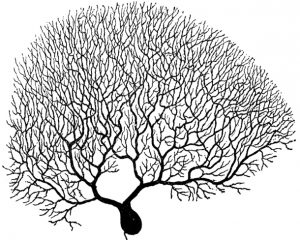The greater understanding of our brain’s abilities, functioning and limitations allows us to periodically improve our teaching skills. The process of learning a new skill doesn’t have to be complicated. In fact, as long as a system is put in place and regularly followed the easier it becomes to learn and retain knowledge and skills. I’m going to list several learning techniques and the logic behind the effectiveness of each so you too can growth hack your way to learning and retaining any skill faster.
Key takeaway: Intelligence level is not fixed; it can grow and change.
And So It Begins
So let’s start at the beginning. When we are born we have roughly 100 billion neurons or brain cells. As we learn, practice, listen and teach our neurons develop little “fibers” called dendrites which allow us to connect to other cells. Not only do these dendrites stem from the cells, but also from each other as we start to build and build upon the knowledge we already have. Imagine the growth of a tree, starting from a seed and developing branches and as it continues to be nourished (in our case knowledge) more branches begin to stem from its existing foundation. The more dendrites our brain creates the faster we can store and access memory.

Growing your dendrites is a slow process and takes practice. When two dendrites get closer together, chemical or electrical messages are sent from one neuron to another, through the contact point between the dendrites, called the synapse.
Learning a subject or skill involves growing topic-specific dendrites to connect specific neurons at specific synapses. Your neurological network grows bigger and bigger with each additional piece of information learned. For each of the 100 billion neurons you have you can grow as many as 10,000 connections (synapses)!
Although we do not know exactly how the brain works we’re beginning to embark on new discoveries everyday. From what science tells us, neuroplasticity or brain plasticity is the leading contributor to our learning and memory retention.
Brain plasticity serves us in a few different scenarios:
- Brain organization: Specifically at the beginning of life
- Brain compensation: Lost functions or maximizing of remaining functions due to brain injury
- Acquisition of new knowledge: Anytime new knowledge is obtained
One of the coolest things about our brains is that it is constantly adapting and never capped on the amount of information and new skills we are able to learn. Through practice and repetition of mental exercising we’re able to form more and more neural connections.
Now that we have a general understanding of how the brain functions — let’s take a look at how we can effectively implement simple strategies in order to foster new neural connections and maximize our learning.
One of the most commonly mentioned and fundamental learning techniques is repetition. No doubt, the more you practice the better you will become at any task at hand. However, one of the most overlooked types of repetition is simply through visualization. Research has found that similarly as physically training your motor functions to behave in a certain way to reach perfection is effective, (Ex. perfecting a golf swing, basketball shot, riding a bike, playing an instrument etc.) the act of consistently visualizing or mental rehearsal of these actions is just as important.
The Power of Visualization 👁
Dr. Biasiotto from the University of Chicago conducted a study where he separated people into three groups and tested each group on the number of free throws they could make.
Afterwards, he told the first group to practice free throws every day for an hour. The second group he had everyday just visualize themselves making free throws. The third group he instructed to do nothing. After 30 days, he tested them again on the number of free throws.
What he discovered was astounding! The first group had improved by 24%. The second group improved by 23% without even touching a basketball! The third group expectedly did not improve at all. If you don’t use it, you lose it.
Of course this doesn’t mean that you can just sit around and visualize your way to learning a skill or language with out incorporating other aspects into your regimen. However, just imagine how exponentially impactful coupling visualization with consistent practice can be.
Break It Down 🕺
As the saying goes, how do you eat a whole elephant? One bite at a time. Cliché, I know, but it works. The organization of these small bites can play a huge role in the overall consumption. Breaking down a task into its most basic parts allows you to reconstruct the skill in its entirety piece by piece. For example, learning a language can be a very overwhelming challenge. Once you approach the language and learn from many different angles, it makes the process more manageable. Some neat tricks that I’ve found to work extremely well when learning a language:
- Use tape and label objects around my home with the targeted language. I consciously and subconsciously rewire my brain to associate those objects in the new language.
- Role play situations that I could find myself in such as doing a transaction at the bank. Write down the phrases that I would use in English and look up the translation. Of course, it always helps when you have a native language speaker to correct the translations.
- Flash cards are the holy grail for repetition, especially if you create them yourself.
The point of listing some of these helpful tips is to essentially showcase that by tackling the language in a variety of smaller tasks it makes it more manageable. Breaking down the tasks also allows for your brain to process and organize information without feeling overwhelmed. Nothing brings us to a halt faster than overloading or creating options paralysis. Although our brains appreciate new information, when there is too much of it we become overwhelmed. Our minds simply can’t divide our attention between all the different elements.
The Power of Teaching 🎓
There’s something to be said of wanting learn and even more about bestowing your newly acquired knowledge upon others. Retention rates have been found to be as high as 90%! When we teach others it reinforces our own knowledge in a variety of ways.
Even if you’re not an expert, you’ll inevitably learn more by way of your own curiosity. What’s noteworthy is that it’s alright if you don’t have all of the answers because you can always make an effort to find the requested info. Another way to think about teaching others without the pressure is to simply share what you have learned as it allows you to rehearse and review your current understanding of the particular topic.
What is known as “the protégé effect”, studies have shown that when we take the responsibility of explaining something to other people, we end up understanding it better ourselves. The process of teaching others helps us recognize gaps in our own understanding and better organize information in our brains.
Initially, we’re better at taking in the information when we’ve created the mindset to think we’re going to be teaching it to someone else later. We soon realize that we need to pay attention to the most important details and organize them in our minds, if we’ll be teaching someone else. Students who are given the responsibility to tutor others, researchers have found, actually work harder to understand the material, recall it more accurately and apply it more effectively.
Set Yourself Up for Failure‼️
A great way to speeding up the learning process is to set things up so that you’re sure to fail—by taking a difficult problem head on without any help or instruction. Research has shown that people who try solving math problems in this way don’t come up with the right answer—but they do get the creative gears turning and come up with what potential solutions would look like, leading them to perform better on such problems in the future. This is called “productive failure,” and can be implemented in your own learning by allowing yourself to struggle with a problem for a while before seeking out help or information.
For example, think about learning how to play the piano. You can easily search for the sheet music for a song online, but it’s not going to help you learn the actual sound of each key you’re playing. Instead, figure it out on your own rather than seeking out the answer. Basically this is learning by trial-and-error, which no doubt is frustrating, but works very well. Of course, sometimes you will need to give in and search for a solution, but you’ll be better off if you don’t.
The Subconscious 🧠
We often forget the exponential and powerful role the subconscious has over the brain. If used properly, we can see tremendous results. Don’t underestimate of its power to bring changes in your life. Remember, whenever your subconscious accepts an idea, it will immediately begin to execute it. It uses all its energy and utilizes all the mental and spiritual laws of your deeper mind. This law is true for good or bad ideas. Consequently, if you use it negatively, it brings trouble, failure, and confusion. When you use it constructively, it brings guidance, freedom, and peace of mind. So how is this applicable to learning? Well once you realize that the subconscious can aid in the motivation as well as do a majority of the heavy lifting for you when you’re idle, the sooner you can harness its power for memory retention.
As mentioned, there are a variety of ways to approach learning. Understanding the brain’s complete capabilities we can use these techniques to really propel us to the next level. Practice is still necessary when embarking on any new skill, but perhaps with your new found knowledge you’ll be growth hacking your way a little faster. Oh yea, and make sure to have some fun.








